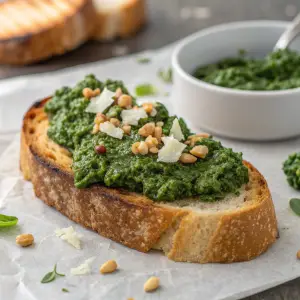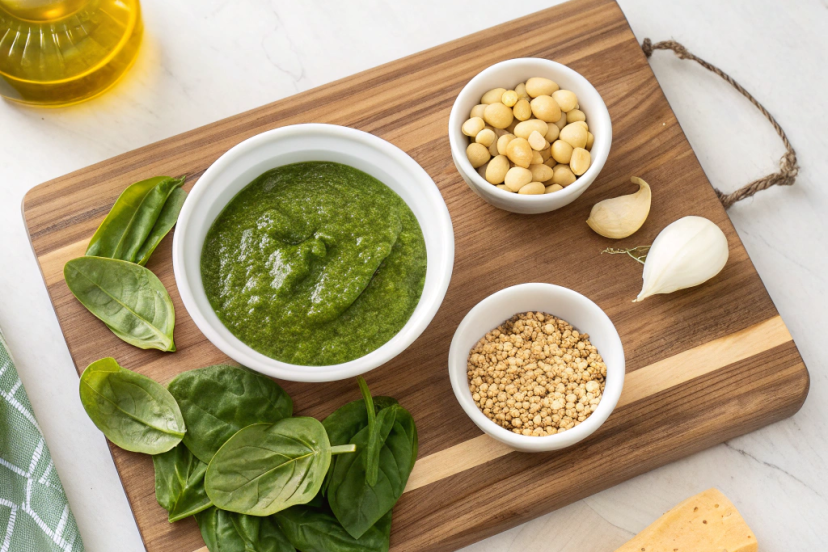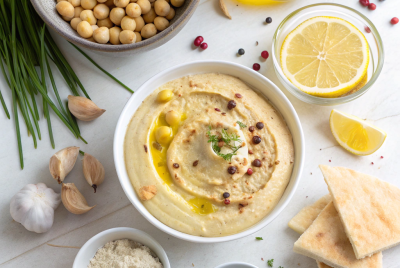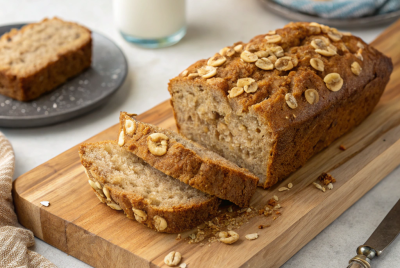Spinach Pesto Recipe (Better Than Basil!)
Why This Spinach Pesto Recipe is a must-try!
If you’ve only ever made traditional basil pesto, this spinach pesto recipe will revolutionize your weeknight dinners. I started making this when my basil plants couldn’t keep up with my pesto obsession, and honestly, I now prefer this version. The spinach creates a smoother, creamier texture while keeping that bright green color we all love. Plus, it’s significantly more budget-friendly—a bunch of basil costs three times what spinach does at my local market. This pesto works beautifully on pasta, as a sandwich spread, stirred into soups, or even as a pizza sauce. The mild flavor means it won’t overpower delicate proteins like fish or chicken, and kids who turn their noses up at basil often devour this without complaint.
Spinach brings serious nutritional power to this recipe that makes it more than just delicious. We’re talking about one of the most nutrient-dense leafy greens available, packed with iron for energy, vitamin K for bone health, and folate that’s essential for cell function. The lutein and zeaxanthin in spinach support eye health, while its high levels of antioxidants help fight inflammation. Unlike some vegetables that lose nutrients when cooked, spinach actually becomes more bioavailable when lightly processed like this—meaning your body can absorb those nutrients more easily. Paired with heart-healthy olive oil and nuts, this pesto becomes a powerhouse condiment that makes eating well feel effortless and indulgent.
Printable Spinach Pesto Recipe Card

Spinach Pesto Recipe
Equipment
- Food processor or high-powered blender
- Rubber spatula
- Airtight storage containers or jars
- Cheese grater (if using fresh Parmesan)
Ingredients
- 4 cups fresh spinach leaves packed (about 4 oz)
- 1/2 cup fresh basil leaves optional but adds depth
- 1/2 cup pine nuts or walnuts, almonds, or pepitas
- 3 cloves garlic peeled
- 1/2 cup extra virgin olive oil
- 1/2 cup freshly grated Parmesan cheese
- 2 tablespoons fresh lemon juice
- 1/2 teaspoon salt adjust to taste
- 1/4 teaspoon black pepper
Instructions
Step 1: Prepare the Spinach
- Wash the spinach thoroughly and pat dry with paper towels or use a salad spinner. Remove any thick stems. If using frozen spinach, thaw completely and squeeze out all excess moisture—this is crucial for the right consistency.
Step 2: Toast the Nuts (Optional but Recommended)
- Place pine nuts in a dry skillet over medium heat for 2-3 minutes, stirring constantly until fragrant and lightly golden. This deepens the flavor significantly. Let cool for 5 minutes.
Step 3: Blend the Base
- Add spinach, basil (if using), toasted nuts, and garlic to your food processor. Pulse 10-15 times until roughly chopped and combined.
Step 4: Add Liquids
- With the processor running, slowly drizzle in the olive oil through the feed tube. Scrape down the sides as needed. Continue blending until you reach your desired consistency—I prefer mine slightly chunky for texture.
Step 5: Finish with Cheese and Seasoning
- Add the Parmesan cheese, lemon juice, salt, and pepper. Pulse another 5-10 times until well combined. Taste and adjust seasoning—you might want more salt, lemon, or a pinch of red pepper flakes.
Step 6: Store or Serve
- Use immediately or transfer to an airtight container. If storing, pour a thin layer of olive oil on top to prevent oxidation.
Nutrition
Pro Tips for Perfect Spinach Pesto
- Don’t skip the lemon juice – It brightens the flavor and prevents the spinach from tasting too “green” or earthy
- Room temperature ingredients – Cold ingredients don’t emulsify as well; let your cheese and nuts come to room temp
- Add pasta water – When tossing with pasta, reserve 1/2 cup starchy pasta water to help the pesto coat better
- Blanch for brighter green – For restaurant-quality color, blanch spinach for 30 seconds, shock in ice water, then squeeze dry before blending
- Double the batch – This freezes beautifully, so make extra when you’re already cleaning the food processor
Storage Instructions
Refrigerator: Store in an airtight container with a thin layer of olive oil on top. Keeps for 5-7 days.
Freezer: Freeze in ice cube trays, then pop out and store cubes in freezer bags for up to 3 months. Each cube equals about 2 tablespoons—perfect for single servings.
Room Temperature: Do not leave out for more than 2 hours due to the fresh garlic and cheese.
Dietary Adaptations for this Spinach Pesto Recipe
Vegan: Omit Parmesan and add 2 tablespoons nutritional yeast plus an extra pinch of salt. Some add white miso for umami depth.
Dairy-Free: Same as vegan option above, or simply omit the cheese and increase salt to taste.
Keto: This recipe is already keto-friendly! Contains approximately 2g net carbs per serving.
Gluten-Free: Naturally gluten-free as written. Just ensure your serving accompaniments are GF.
Diabetic-Friendly: Low in carbohydrates and high in healthy fats, making it excellent for blood sugar control. The fiber from spinach also helps.
Nut-Free: Replace pine nuts with roasted sunflower seeds or pepitas (pumpkin seeds) in equal amounts.
Low-Sodium: Use unsalted nuts and reduce or omit added salt. The Parmesan provides natural saltiness.
Serving Suggestions
- Classic Pasta: Toss with hot pasta (penne, spaghetti, or fusilli) and reserved pasta water
- Protein Topper: Spoon over grilled chicken, salmon, or shrimp
- Sandwich Spread: Use instead of mayo on sandwiches, wraps, or panini
- Veggie Dip: Thin with a bit more olive oil and serve with crudités
- Breakfast Boost: Swirl into scrambled eggs or spread on avocado toast
- Soup Enhancer: Stir a spoonful into minestrone, white bean soup, or tomato soup
- Pizza Base: Replace tomato sauce with pesto on homemade or store-bought pizza
- Roasted Vegetables: Toss with roasted cauliflower, potatoes, or Brussels sprouts
Similar Recipes
Creamiest Hummus Recipe Without Tahini
How to Make Vegan Hollandaise Sauce
A Personal Note about this Spinach Pesto Recipe
I’ll never forget the first time I made spinach pesto out of desperation. It was a Tuesday night, I had a pound of pasta boiling, and my “definitely fresh” basil had turned into a slimy mess in the back of my fridge. I spotted the spinach container and thought, “Why not?” My family was skeptical when they saw the bright green sauce hit their plates, but after that first bite, my ten-year-old declared it “better than the restaurant kind.” Now it’s our weeknight staple, and I keep cubes of it stashed in the freezer for those evenings when cooking feels impossible. There’s something deeply satisfying about taking humble spinach and transforming it into something that makes ordinary pasta feel special. This recipe has taught me that sometimes the best kitchen wins come from improvisation and being willing to break from tradition.
Frequently Asked Questions
Q: Can I use frozen spinach instead of fresh?
A: Yes! Use one 10 oz package of frozen spinach, thawed and thoroughly squeezed dry. You’ll need to remove as much moisture as possible—I wrap it in cheesecloth and twist hard. The flavor will be slightly more concentrated, which isn’t a bad thing.
Q: Why does my pesto turn brown after storing?
A: Oxidation causes the color to darken, which is normal and doesn’t affect safety or taste much. To minimize it, press plastic wrap directly onto the pesto surface before sealing the container, or pour a thin layer of olive oil on top. Blanching the spinach before blending also helps maintain color longer. Adding a squeeze of lemon juice acts as a natural preservative.
Q: What’s the best nut substitute if I’m allergic?
A: Sunflower seeds or pepitas (pumpkin seeds) work beautifully and provide similar texture and healthy fats. Toast them just like you would pine nuts. Some people use hemp hearts, though the texture will be slightly different. For nut-free and seed-free, increase the Parmesan and add an extra tablespoon of olive oil.
Q: Can I make this without a food processor?
A: Yes, though it requires more effort. A high-powered blender works well—just scrape down the sides frequently and add the oil gradually. In a pinch, you can finely chop everything by hand and stir together, but you won’t get that creamy emulsified texture. An immersion blender in a tall container can also work if you’re patient.
Q: How do I prevent the garlic from being too overpowering?
A: Raw garlic intensifies as it sits, so if you’re sensitive to it, reduce to 2 cloves or blanch the garlic cloves in boiling water for 1 minute before adding them. The lemon juice helps mellow the sharpness. If your pesto tastes too garlicky after making it, stir in an extra tablespoon of Parmesan and a bit more olive oil to balance it out.




